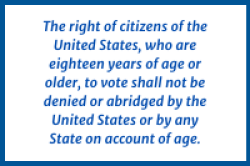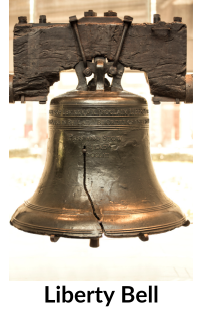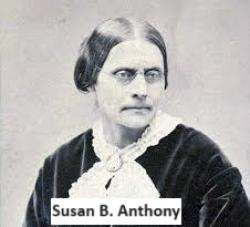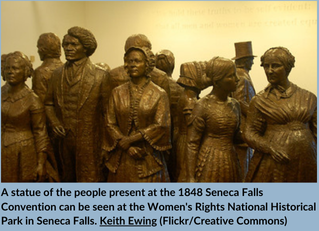
By Teresa Carroll, LWVBC Member
The right to vote is essential to a well-functioning democracy. There are many historic moments that occurred in the month of July to expand voting for previously disenfranchised American citizens. Here are some to commemorate.
July 1, 1971: The 26th Amendment to the Constitution expanded voting rights to younger adults.
 In the 1970 case Oregon v. Mitchell, a divided U.S. Supreme Court ruled that Congress had the right to regulate the minimum age in federal elections, but not at the state and local level. Amid increasing support for a Constitutional amendment, Congress passed the 26th Amendment in March 1971. In just over two months–the shortest period of time for any amendment in U.S. history–the necessary three-fourths of state legislatures (or 38 states) ratified the 26th Amendment. It officially went into effect on July 1, 1971. It is the last in a series of amendments enacted over more than a century expanding constitutional protection for voting rights. Many more voices were able to be heard in elections!
In the 1970 case Oregon v. Mitchell, a divided U.S. Supreme Court ruled that Congress had the right to regulate the minimum age in federal elections, but not at the state and local level. Amid increasing support for a Constitutional amendment, Congress passed the 26th Amendment in March 1971. In just over two months–the shortest period of time for any amendment in U.S. history–the necessary three-fourths of state legislatures (or 38 states) ratified the 26th Amendment. It officially went into effect on July 1, 1971. It is the last in a series of amendments enacted over more than a century expanding constitutional protection for voting rights. Many more voices were able to be heard in elections!July 4, 1776: Independence Day is much older than a summer blockbuster movie and picnics!
Independence Day, known as the fourth of July, became a federal holiday in the United States in 1941. The celebrations however, have been occurring much longer than the past 79 years. The tradition of Independence Day commemorations go back to the 18th century and the American Revolution. On July 2nd, 1776, the Continental Congress, voted in favor of independence, and two days later delegates from the 13 original colonies adopted the Declaration of Independence. This historic document explained to England’s King George II, and the world why thecolonies regarded themselves as independent sovereign states no longer subject to British colonial rule.The conflict between England and the colonies was already underway, and the American Revolutionary War continued until 1781. July 4th has since been celebrated as the birth of American independence.
When one thinks about the original Independence Day, the Liberty Bell may come to mind. It was  rung four days after the first public reading of the Declaration of Independence in Philadelphia. Did you know that Pennsylvania suffragists had a replica bell cast called the Justice Bell? During their campaign to promote a state constitutional amendment for women’s voting rights in 1915, the women carried on an open truck and rough roads, their Justice Bell. The Justice Bell added the words: “establish JUSTICE" to the inscription. The clapper was chained so it did not ring, to symbolize the silence of women.
rung four days after the first public reading of the Declaration of Independence in Philadelphia. Did you know that Pennsylvania suffragists had a replica bell cast called the Justice Bell? During their campaign to promote a state constitutional amendment for women’s voting rights in 1915, the women carried on an open truck and rough roads, their Justice Bell. The Justice Bell added the words: “establish JUSTICE" to the inscription. The clapper was chained so it did not ring, to symbolize the silence of women.
July 4, 1876: Women Protest at the Independence Day Centennial Celebration in Philadelphia
 She was
She was not given a place on the agenda. The original Declaration of Independence was read aloud from a stage in Independence Square. After the reading, Susan B Anthony and four other women rose and brought their declaration to the dignitaries on stage. They walked to the other side of the building and read the declarations, prefaced with “We ask justice, we ask equality, we ask that all the civil and political rights that belong to citizens of the United States, be guaranteed to us and our daughters forever.” Their actions were key in the eventual passage of the 19th amendment in 1920. Read a transcription of the declaration here.
July 19-20, 1848: The Seneca Falls Convention launched the women’s suffrage movement.
 social, civil and religious rights of women. In spite of little publicity, 300 people attended. They drafted a Declaration of Sentiments, which echoed the language of the Declaration of Independence. It was signed by 68 women and 32 men. Notably, Fredrick Douglass was a signer and the only non-white person in attendance. Women's Rights National Historical Park , in Seneca Falls New York, tells and interprets the story of the first Womens’ Rights Convention.
social, civil and religious rights of women. In spite of little publicity, 300 people attended. They drafted a Declaration of Sentiments, which echoed the language of the Declaration of Independence. It was signed by 68 women and 32 men. Notably, Fredrick Douglass was a signer and the only non-white person in attendance. Women's Rights National Historical Park , in Seneca Falls New York, tells and interprets the story of the first Womens’ Rights Convention. -
Elizabeth Cady Stanton, the driving organizer of the Seneca Falls Convention, and a leading women’s rights activist.
-
Lucretia Mott, a Quaker preacher from Philadelphia, who was known for her anti-slavery, women’s rights and religious reform activism.
-
Mary M’Clintock, the daughter of Quaker anti-slavery, temperance and women’s rights activists. In 1833, M’Clintock and Mott organized the Philadelphia Female Anti-Slavery Society.
-
Martha Coffin Wright, Lucretia Mott’s sister. In addition to being a lifelong proponent of women’s rights, she was an abolitionist who ran a station on the Underground Railroad from her home in Auburn, New York.
-
Jane Hunt, another Quaker activist, was born in Philadelphia, and married into the M’Clintock’s extended family.